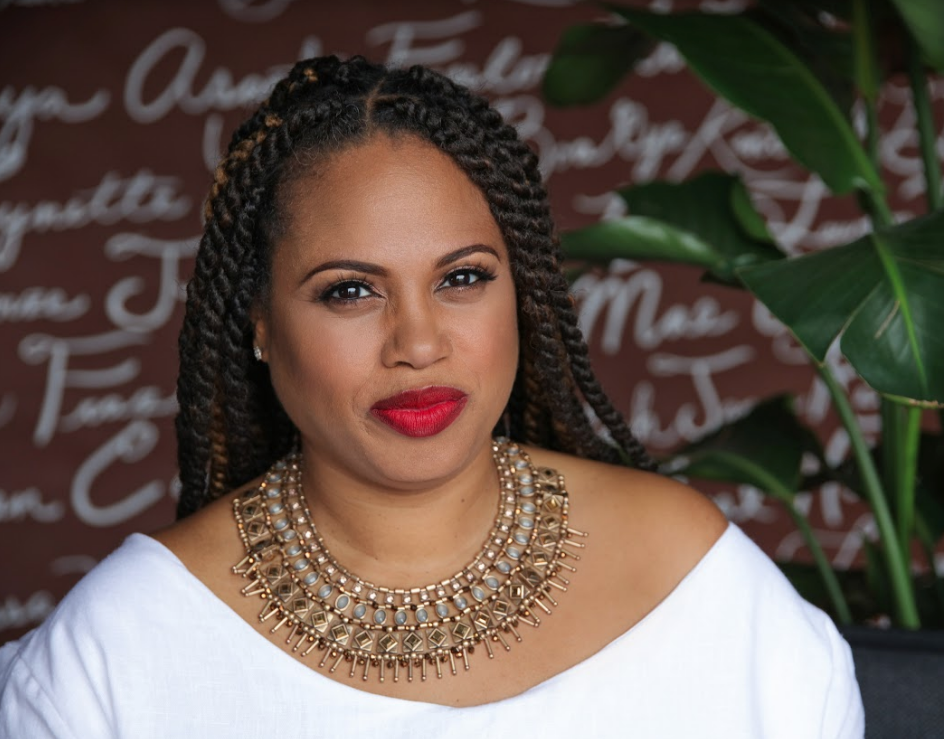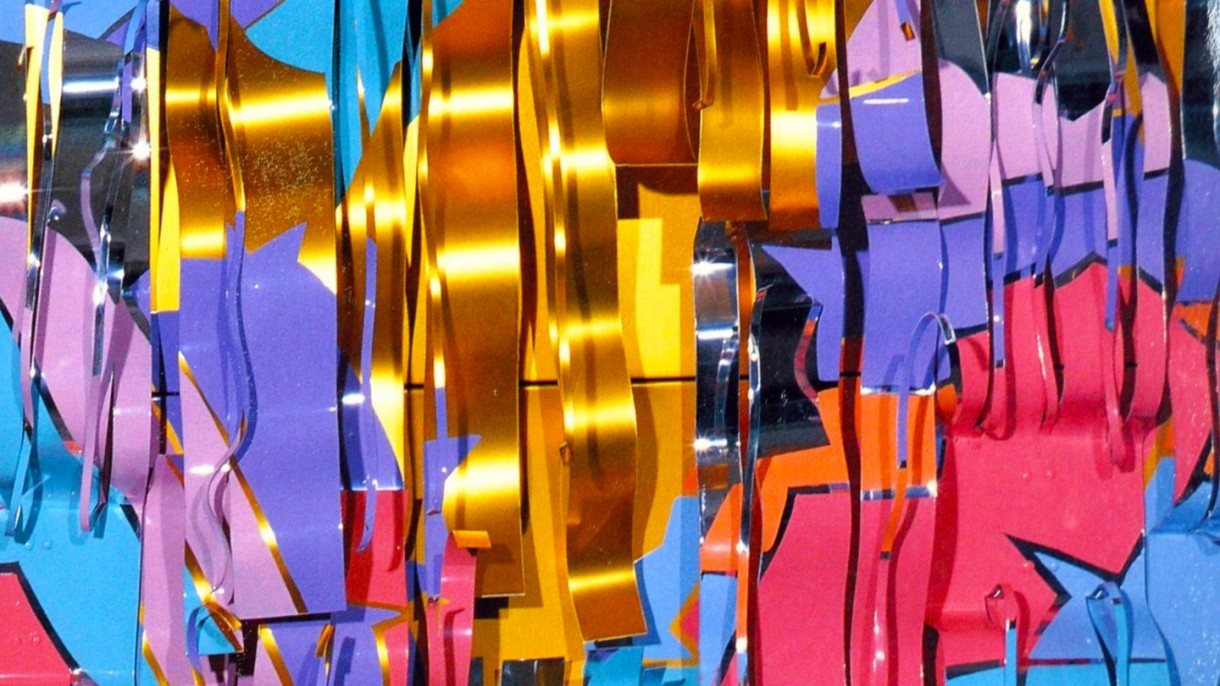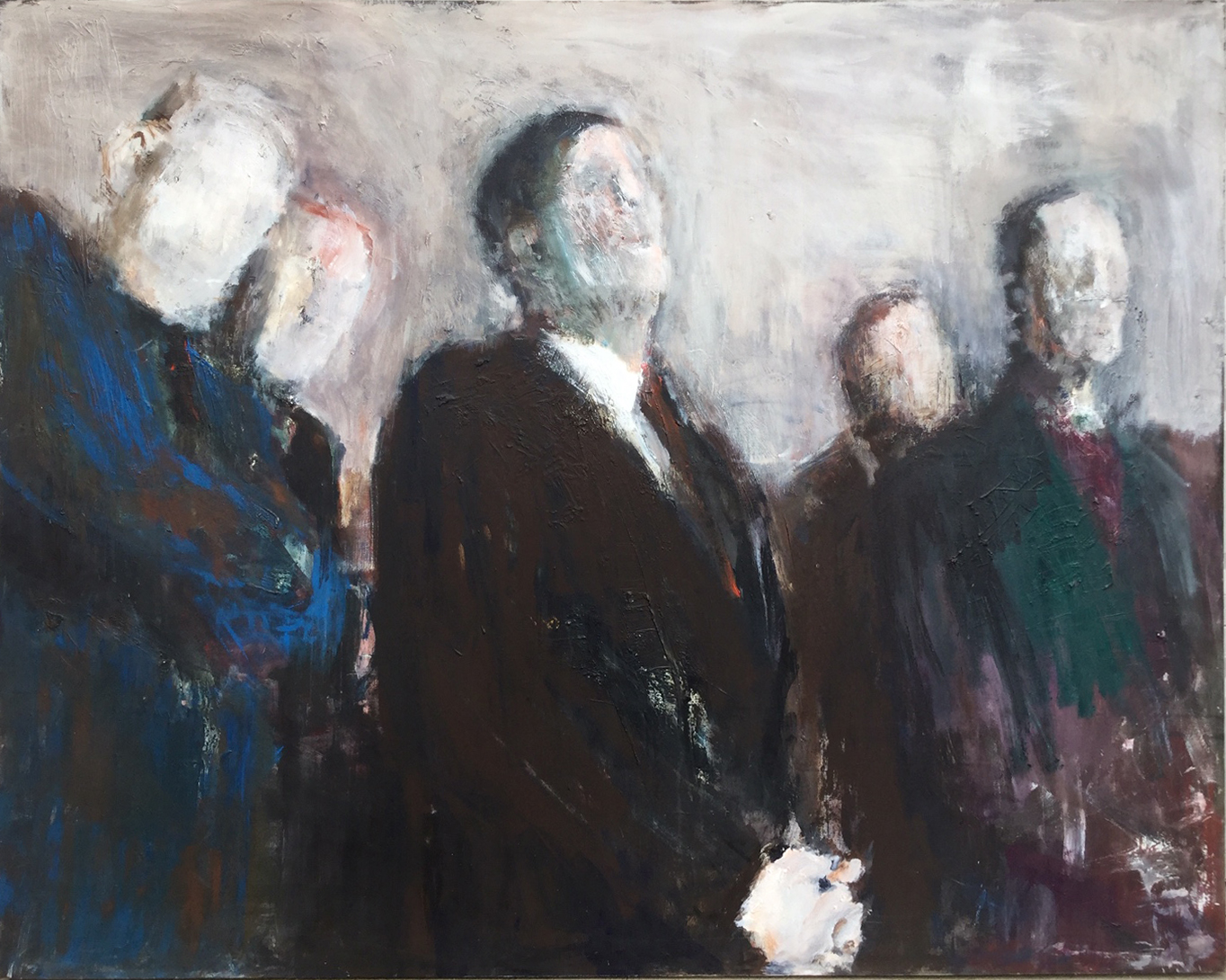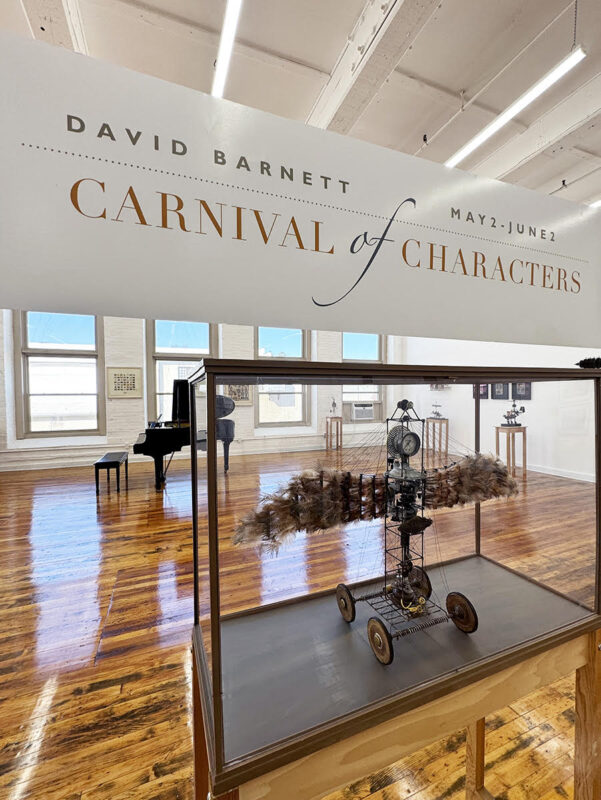Ruth Pettus’ enormous paintings of isolated massive figures emerged in exhibitions locally in the early 1990s. Each painting portrays a single mysterious male form wearing a suit that hangs like soaked armor. The figures are slathered together beneath layers of paint atop a hazy ground. The colors are stark, the contrast high. They are foreboding. Many people, including me, considered this work political commentary—images of isolated government men, potentially dangerous. Pettus debunks this idea, but says she is OK with however viewers read her work. Y:ART Gallery has chosen a selection of these early paintings for her retrospective.
Her “shoe series” soon followed. For this series the Baltimore-based artist mangled and transformed thousands of used shoes, combining them with myriad other material such as wax and plastic. When shown in mass, they portray a long, otherworldly march of surreal, delightful, disturbing objects, each one blooming into the others.
Slowly Pettus added other imagery to her paintings over the years and these were then repeated in series. All have a strong emotional connection for the artist. When she moves to landscapes, rivers, horses, and people strolling in piazzas the paintings still maintain a commonality—the shimmering ground/object haze and muted tones. Over time they became less ominous and more lyrical, as the haze within shimmers with a classical light.
The artist has long distanced herself from the academy and its penchant for conceptual conceits. She sticks to down-to-earth explanations. She follows her instincts. Pettus’s work practices have always been instinctive not conceptual, she is a non-stop, highly inquisitive maker. In 1978 as a young woman she left art school behind and set off on her own journey. She never stopped. Pettus’ images are culled from a lifetime of travel and experience, of looking, making, and teaching art her way. Along the way she gained a large following in the Baltimore region where she is highly regarded, especially within the arts community.
These days her work has slowed down—not intentionally, but she accepts the situation. She survived a brain tumor 30 years ago. A miracle, her doctors say, but now a related 2016 stroke has impacted her mobility; further illness is again nipping at her. She has to undergo chemotherapy on a regular basis. She keeps going and remains upbeat. Pettus still makes art, still shows art, and here she talks art. When I spoke to her for this interview, a couple of days before her opening at Y:ART, she was straightforward but also insightful and droll—just like always.

Julia Yensho and Ruth Pettus
Jack Livingston: Let’s start off talking about the exhibition.
Ruth Pettus: Julia Yensho [Y:Art Gallery director] showed some interest in my work and asked me to do this show. I had been to her gallery before. I’d seen a couple of shows and she has a good reputation as a serious gallery owner. I immediately said yes. She was very interested in showing the big paintings. I thought it wouldn’t all fit. So I’m going to be very curious to see how she’s got it in there. I haven’t seen the show up yet. I have trouble getting over there. It is mostly my early work, the big paintings of mostly men, and the “piazza paintings” of people together. We decided not to show my shoe series.
It’s a retrospective of early paintings then. You were born in New Zealand in 1957? That’s exotic!
My father had just joined the foreign service and then spent a couple of years in the Philippines in Manila, and then was sent to New Zealand. That’s where I was born. My mother was from England outside of London, from Waterford. And my father was from St. Louis. He was an American and they met when my mother was working in Yeager, a big wool shop in England, in the basement, in the export department. He came to send some stuff to his mom and his sister and bingo—he asked her out. I was born in New Zealand but left before I was one. We went to London. I can’t get any kind of New Zealand passport because my dad was with the American diplomatic regime. But I can proudly call myself a Kiwi. He worked in London for 12 years. My father was attaché to the embassy. Eventually we got sent to Australia.
New Zealand, London, Australia. How old were you when you went to Australia?
Fourteen. My sister’s one year older than I am, and she just immediately placed herself there and had all kinds of contacts and was very happy and I was… very angry. I have an older brother, Winston, and then Catherine, Catherine and I are Irish twins. And then I have a younger brother, William, and a younger sister, Rachel, who lives in Cyprus.
When did you decide that art was something that you wanted to do in life?
As younger girls, we were all about horses and we were able to have our own horses in Australia, but it wasn’t a balm for my wounds. I was always able to draw, you know. Even as a young kid. Then I saw a film called Don’t Look Now. A classic, and it was about a person doing art restoration. I thought then I wanted to do art restoration. I went to the University of Sydney for a year, studying art history and Italian in archeology in French, hoping that I could approach this job with a sense of art history. My parents moved back to Washington, DC and I came to visit. My mother said, “I’ve already found someone you can speak to about art restoration.” And he was a very stern German man who did his work at the basement of the National Gallery. I went to see him, and he read me the riot act. He said if I didn’t have chemistry or any kind of science background, forget it. So that was the end of that.
And then I lived in Greece on the Greek islands for four months. And that’s when I really started to spend my days doing some pastel drawings. I was sleeping on the beach; I had a tent. It has good vacation places. It was great. I love the Greeks, they’re super generous.
Wow. That got you started. Did you attend any further school?
Well, I went home because my mother was ill. When I arrived, she told me she had met a woman who was taking painting classes with Leon Berkowitz. I was very interested in Rothko’s paintings and the Abstract Expressionists. Berkowitz was here at the Corcoran in Washington, DC. I first started doing some drawing there. My mother had colon cancer. It had been misdiagnosed. At that time in the 1970s no one was talking about colon cancer. My father had taken leave to take care of her. Then she died.
That must have been very hard. You were only 19.
Yes, it was difficult on us all. So, by that time I was working with Berkowitz. He was a great teacher.
What was behind your interest in Abstract Expressionism?
It was the gesture. In Australia the government had bought this Jackson Pollock painting called “Blue Poles” and there was an enormous outcry about how they could pay $2 million for this painting. But it was just a gorgeous painting. It got me much more interested in Abstract Expressionism. And I liked to dance, so gesture and movement was important for me. Then I saw some Rothko. I mean, who doesn’t like Rothko? He’s a great gateway painter for anyone who doesn’t care for abstract work.
You went to the Corcoran though, you studied there in the late 1970s, right? Did you graduate?
No. I did get into the degree program there, but I couldn’t stick it. I had some great teachers, but I felt like no one was saying anything about my work there. The only thing I really liked was the art history class. I got the art history prize!
What were you painting then?
Just the class work and it had quite a bit of gesture in it. I wasn’t really “painting, painting.”
When did you start “painting painting”?
When I left the Corcoran. I left after just three months. I was using oil pastels. I started working on that technique at school. I found a studio at 12th and H way up in those old buildings in DC. I started using polyurethanes, doing some quite interesting work I think. I started painting with paint. I would layer polyurethane to trap light. Pouring, brushing and rolling it on. They are all gone. I didn’t get them out of there.
I wanted a bigger studio, which was unaffordable in DC. In the 1980s I came up to Baltimore, where I found a 3,000-foot studio at South Charles and Lombard Street. I started going to a lumber company on Caroline Street where I bought these really long pieces of wood, 16 feet to 10 feet. I would make terrible stretchers. I painted on them with ink and gesso, which is interesting because the light reflection created kind of a bronze image for the figures. They were OK.
When did you start making the paintings of men in suits?
They came about when I got fed up with Baltimore. My son Max was two. We went to Paris first. It didn’t work out. So we went to London in 1983 to stay with my brother Andy. I was in the British Museum and I saw these giant cartoons by Raphael. They are quite astonishing. There was one, the one of Peter receiving the key from Jesus, and behind them there is a group of men in togas in a line. And I thought, I just saw that outside—the white men were not wearing togas, they were wearing suits. It just occurred to me that that would be an interesting theme to work on because the men, the clothed man was not a real figure except in portraiture. I mean, you know, Francis Bacon and Lucian Freud had worked with males.
Back in Baltimore I went to see this Canadian play at Theater Project. There was a man who came out in a suit and his shadow was projected completely on the screen behind him and he performed a monologue. I went home and the next day I painted what I had seen.

Ruth Pettus, “Man Wearing a Red Tie”
I saw the paintings of men in suits first in Washington, DC.
Oh yes, on Du Pont Circle, at a show called show called Washington and Baltimore. They picked a couple of them. That was ages ago.
That’s the place. That was the first time I saw your work and to me they seemed ominous, scary. They felt political, like a feminist response to the dominance of the corporate male. Anti-patriarchy work. What do you think of that? Was that a correct reading?
No. Not entirely. I was interested in the suit as much as I was the man, because I thought the dark crevices, how they were a kind of dark abstraction. The tie is the central plumb line almost. I had a psychiatrist argue, try and tell me that these were about my father. I said, no not really [laughs]. I was upset with that one. I’m just saying people will feel their way.
From your point of view then, people project their own issues, their own agenda, on the paintings and the paintings provoke myriad responses. But you were approaching them in a more formal way that was separate.
I remember George Ciscle saying, “When are you going to start painting women in suits?” And I had absolutely no interest in doing that.
The suit is a power uniform. It’s a corporate uniform, a business uniform, a government uniform associated with men.
Well, I’ve always liked suits.
When I had come back from England, Alex [Pettus’ then-husband] took loads of photographs of men downtown in very casual situations. And so I used them to do lots of ink wash on paper, which I’d never done before. I showed them at Oram “Jerry” Wahl’s frame and art shop, Partners, on Chase Street. Jerry knew Alex and had seen my washes and said, “I’d like to give her a show.” That year was the same year I was diagnosed with a brain tumor. So it was a hard summer getting through this. It was great that I would have this show afterwards.
That is very young to get a brain tumor.
Yeah. And look at me now, 30 years afterwards. My doctors say nobody lives this long. So obviously something was good for me in the stars, but I didn’t know that at the time. I just kept poking along. I realize now how lucky I am to have been able to raise Max, to have a baby and all that stuff.
Yes, plus you went on to continue to create these paintings and they were successful. You got known for those.
Well, I got known but I didn’t sell. So that’s why I have this big inventory. I got pretty good press coverage. Still, no serious gallery wanted to take me on or promote me.
That’s true of 95 percent of artists, particularly in Baltimore. But I certainly knew who you were from those paintings. And many other people I knew did too.
Then the men paintings started to morph into smaller groups of figures. That’s when the “piazza paintings” came around. I was looking at groups, Bruegel, and looking at people in crowds. I was interested in going from one solid form into a group. The work got some good attention. Megan Hamilton who worked at the Creative Alliance was writing for City Paper then and she wrote a piece about a show. George Ciscle had his gallery up on Morton Street and he liked the work. The next year, he bought a piece. By then I started to work color into them. So I showed there, at the Resurgam Gallery, the Cultured Pearl—the galleries in the region.

Ruth Pettus, “Piazza VI”
What about the shoe series? They are very different. You literally transform shoes. How did that get started?
I reached a point with painting where I felt I was just hitting my head against the wall and I was rereading A Tale of Two Cities. In the beginning it has a coach stuck in the mud…. it was just this fantastic description of people being stuck in the mud and the horse is plunging and falling. That made me want to do a shoe… no real process or thinking really hard about “why do I want to do this shoe?” And so I did it. I used a shoe of mine and I covered it with roofing tar and then I had, out back, a Mimosa tree, it had these little twigs on it, which made this great sound when I snapped them off and put them in the shoe and covered it.
I wasn’t documenting my art then, but I have a card from the very first shoe show called The History in the Life of a Shoe. I put them in Resurgam gallery. An old friend of mine from Washington, Lea Feinstein, was asked to write something about my painting. When she came to visit me she saw a shoe in a corner and said “That’s much more interesting than the paintings” [laughs]. So she looked at all the slippers and she wrote a piece with the Baltimore Chronicle.
And you went on to make many, many shoes, correct?
Yes I would. Because they were selected by School 33 to go to St. Petersburg, to this Russian Gallery. [Part of a 2003 exchange celebration called “Vivat! St. Petersburg” between Baltimore and St. Petersburg. —ED] And while I was in Europe that year with Max I decided it was a good place to make this work. My brother lived in Ireland. I could stay there. I had friends just outside Madrid, so I could stay with them. So that’s what got me making work over there.
Let’s talk about the shoes. First, they are a found object that is transformed with a delicate yet expressionistic quality. They remind me a little of work by Joseph Beuys. They also have a connection to surrealism.
I’m still always surprised how people, whether they have an art background or not, how they perceive them.
How did you perceive them? Are you saying you are not working from an idea, a concept? Beyond the idea from the book you were reading, of a shoe in mud. You’re making the object, and that’s that.
I just did them. Most of my work is fairly spontaneous. And when I started to think about using wax, I changed a lot of things because I was thinking about using wax and putting them in a plastic bag. And that was a whole new thing for me. But I mean, I think some of them as this—there is a French word: réchauffé. It’s a cooking phrase that means “the art of using leftovers.”
I can always immediately identify your work. You grew, of course, there became more finesse to it. But there is always this identifiable figure/ground thing going on, whether it’s an image of a horse or a man or something within a landscape. It’s all a wonderful blur and controlled haze, right?
Can be… There was once a rumor that because I didn’t give the men in my paintings features, that I couldn’t paint faces. So I did a whole series of faces and hands.
No! Ugly art rumors! It got back to you and you took the challenge?
Yes! To say I can actually paint the features of the face. I didn’t know who started it. But the paintings were good… There is one in the show. If I were to offer any kind of advice to people, it is “paint what you know.” I know a lot of people have said that. If you’re going to work with any objects or themes of reality it is important.
It sounds like in your life that you’re most inspired by some action by something that you have seen, photographs, or something you have read. Do you do a lot of reading?
One of the worst things about this whole terrible thing is if I’m lying in bed, it’s hard for me to hold up books.
Do you want to tell us more about what you mean by “terrible thing”?
I mean the stroke, which they now think was caused by my tumor. So I’m doing chemo. Right here. Not right now, but I do it here. The chemo is very convenient. They send it to me through UPS. They are little capsules. I take anti-nausea medicine before I take them. Then I take the them five days in a row and then I stop for a cycle, whenever that is, about 24 or 25 days. They check my blood and do MRIs and I tolerate it all quite well. I’ve done seven cycles so far! I do get very fatigued.
I will continue to work. To work on the shoes. even if I’m in the chair, I’ll make myself. And hopefully I will find places in the US where I can show them as installations. I’ve shown the shoes in Spain, Ireland, and Russia. I’ve always been quite pleased. I would like to show them again.
Ruth Pettus’ retrospective at Y:ART Gallery is up through June 1. For more information, visit the gallery’s website.
This interview has been edited and condensed.
Images courtesy Julia Yensho/Y:ART Gallery.






